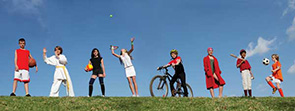
Participation in youth sports is not only booming, it’s something children are starting at earlier ages. According to Dynamic Chiropractic – The Chiropractic News Source, almost 75 percent of families with children between the ages of 5 and 18 have at least one child who plays organised sports, either at school or on a community team. This provides many benefits – learning to work together as a team, boosting confidence, building camaraderie, and consistent physical activity. Correspondingly, as participation increases, injuries increase.
Did you know that almost 40% of all children, teenager and adolescent injuries are sports-related? Injuries in the young athlete are often trivialised. They are usually asked or encouraged to “toughen up and play through the pain.” This approach is not in the young athlete’s best interest for the following reasons:
- It often leads to delayed healing and return to sports.
- It can turn an easily treatable injury into one that becomes difficult to treat.
- In some cases, it can result in a permanent injury that precludes sports participation.
A child has many physical stresses to deal with during their growing years, and problems in children’s spines can occur at almost any point in their development and growth. Factors that will affect the likelihood of a child sustaining an injury are:
- Physical makeup of the child. The natural strength of our ligaments, soft tissues and spine varies from person to person. Other factors such as body weight, posture and even hormonal factors can have an influence.
- In contact sports, the physical maturity of the child compared to their opponents.
- Degree of supervision.
- Use of protective equipment.
- The amount of adequate warm-up.
- The amount of sport played.
Children will benefit greatly from regular spinal and extremity examinations and screenings. Instead of waiting for a painful injury to create a state of pain and instability, young athletes should practice early intervention strategies, introduced to them by their Chiropractor.
Whether providing prevention education, structural adjustments or recommending ways to prevent future injury, Chiropractors have an important role to play with children who are young athletes.
Stretch of the Month
Lower Leg Stretch
The peroneal muscles run down the outside of the lower leg and are difficult to stretch and so often neglected in a stretching routine.
- Sit in a chair with one ankle resting on the other knee.
- With your hands, point the foot (plantarflex) and turn the sole of the foot upwards (invert).
- Hold for between 10 and 30 seconds.
Towards Wellness
Benefits of Exercise

Exercise releases feel-good endorphins and it’s a hard feeling to beat. Twenty minutes of exercise a day or three to four hours per week is what you should be aiming for at the very least. If you’re in an exercise slump, consider ways to change your routine around. Find a fit buddy to motivate you to make those early morning classes, or go for a run or a brisk walk at lunchtime. You’ll get some time out of the office and work up a sweat. Winning!

